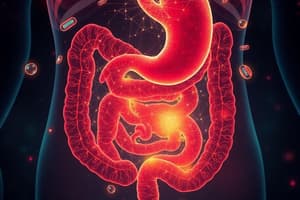Podcast
Questions and Answers
Which of the following are types of laxatives? (Select all that apply)
Which of the following are types of laxatives? (Select all that apply)
- Antidiarrheal
- Stimulant laxatives (correct)
- Osmotic laxatives (correct)
- Lubricant laxatives (correct)
What are examples of stimulant laxatives?
What are examples of stimulant laxatives?
Bisacodyl, Sennosides A & B
What is the mechanism of action of osmotic laxatives?
What is the mechanism of action of osmotic laxatives?
Draws water into the intestines from surrounding tissues
What are some examples of osmotic laxatives?
What are some examples of osmotic laxatives?
What are the effects of saline laxatives?
What are the effects of saline laxatives?
What is a common example of a lubricant laxative?
What is a common example of a lubricant laxative?
What are bulk forming laxatives considered?
What are bulk forming laxatives considered?
What is an example of a stool softener?
What is an example of a stool softener?
What is the main function of opioid antagonists in relation to laxatives?
What is the main function of opioid antagonists in relation to laxatives?
Common adverse effects of laxatives include ______.
Common adverse effects of laxatives include ______.
What should antidiarrheals not be used to treat?
What should antidiarrheals not be used to treat?
What are some adverse effects of antidiarrheal medications?
What are some adverse effects of antidiarrheal medications?
Flashcards are hidden until you start studying
Study Notes
Types of Laxatives
- Stimulant laxatives: Irritate intestinal lining, promoting peristalsis and bowel evacuation within 6 to 10 hours orally and 60 to 90 minutes rectally.
- Osmotic laxatives: Draw water into intestines; commonly used for colon preparation, e.g., GoLytely, lactulose.
- Saline laxatives: Increase intestinal fluid secretion and motility; act within 1 to 3 hours, examples include magnesium hydroxide and sodium phosphates.
- Lubricant laxatives: Such as mineral oil, coat and soften stool while minimizing bowel spasms; aspiration risk related to lipid pneumonia.
- Bulk forming laxatives: Considered safest, they slowly normalize stool consistency, taking 12 to 72 hours to act; examples include wheat bran and psyllium.
- Stool softeners: Facilitate stool passage and typically take up to 72 hours to be effective; commonly used post-surgery (e.g., docusate sodium).
- Opioid antagonists: Target opioid receptors in the gastrointestinal tract to prevent constipation without affecting pain relief; examples include methylnaltrexone and naloxegol.
Stimulant Laxative Examples
- Common examples include bisacodyl (Correctol, Dulcolax) and sennosides A & B (Ex-Lax, Peri-Colace, Senokot).
Osmotic Laxative Examples
- Common agents include lactulose, sorbitol, polyethylene glycol, and glycerin (in suppository form).
Saline Laxative Examples
- Examples include magnesium hydroxide (Milk of Magnesia), magnesium sulfate, magnesium citrate, and sodium phosphates (Fleet's Soda).
Common Adverse Effects of Laxatives
- Potential side effects include abdominal spasms, tenderness, discomfort, nausea, flatulence, bleeding, vomiting, and diarrhea.
Categories of Antidiarrheals
- Classified as local (targeting symptoms directly) and systemic (acting on the body).
Local Antidiarrheal Examples
- Include difenoxin with atropine (Motofen), diphenoxylate with atropine (Lomotil), loperamide (Imodium A-D), and opium (Paregoric).
Systemic Antidiarrheal Examples
- Includes lactobacillus (Lactinex) and bismuth subsalicylate (Pepto-Bismol, Kaopectate).
Antidiarrheal Usage
- Not recommended for diarrhea related to bacterial infections, as the body needs to eliminate pathogens effectively.
Adverse Effects of Antidiarrheals
- Possible adverse reactions include abdominal distention, nausea, constipation, and prolonged or worsening diarrhea.
Studying That Suits You
Use AI to generate personalized quizzes and flashcards to suit your learning preferences.



